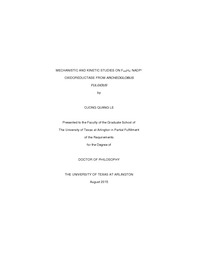
ATTENTION: The works hosted here are being migrated to a new repository that will consolidate resources, improve discoverability, and better show UTA's research impact on the global community. We will update authors as the migration progresses. Please see MavMatrix for more information.
Show simple item record
| dc.contributor.author | Le, Cuong Quang | en_US |
| dc.date.accessioned | 2015-12-11T23:20:09Z | |
| dc.date.available | 2015-12-11T23:20:09Z | |
| dc.date.submitted | January 2015 | en_US |
| dc.identifier.other | DISS-13315 | en_US |
| dc.identifier.uri | http://hdl.handle.net/10106/25381 | |
| dc.description.abstract | F420H2: NADP+ Oxidoreductase (Fno) is an F420 cofactor dependent enzyme that catalyzes the reversible reduction of NADP+ to NADPH by transferring a hydride from the reduced F420 cofactor. F420 cofactor is an essential electron transfer carrier in methanogens. Methanogens play a critical role in carbon cycling because the methanogenic pathway reduces carbon dioxide to produce methane and is therefore linked to energy (1). The focus of this thesis is to study the hydride transfer mechanism of Fno from the extreme thermophile, Archeoglobus fulgidus using site directed mutagenesis, steady-state and pre-steady state kinetic methods. F420 is essential for catalysis within enzymes that are dependent upon this unique cofactor. We are able to purify apoFno and intercalate the cofactor back into the enzyme, and therefore produce active Fno. Our work focuses in part, upon the synthesis of the catalytically active F420 precursor, FO (chapter 2), which is much simpler to obtain, with higher purity than previously published methods grown from bacteria. Using the newly synthesized FO, Fno activity was restored in the absence of F420. Investigating the FO-dependent NADP+/NADPH redox process by stopped-flow spectrophotometry, steady-state kinetics were defined as having a Km of 4.00 0.39 M and a kcat of 5.27 0.14 s-1. Chapter 3 reports the optimized expression and purification method for recombinant Fno. The Fno gene was optimized for expression in Escherichia coli. Modified growth conditions, and purification protocol involving a key polyethyleneimine precipitation step resulted in a highly purified, homogeneous preparation of Fno that displayed high catalytic activity with FO.Once the key components of the reaction, FO and Fno were easily obtainable, efforts were then focused on rigorous kinetic analysis of the enzyme. We have characterized wtFno, as well as Fno variants using steady state and pre-steady state kinetic methods. We report the very first example of half-site reactivity and negative cooperativity involving an F420 cofactor dependent enzyme. While the steady state kinetic analysis showed classic Michaelis-Menten kinetics with varying concentrations of FO, such plots were not displayed with varying NADPH concentrations. When the NADPH steady-state data was converted to a double reciprocal plot, it displayed a downward concave shape, suggesting that negative cooperativity occurs between the two identical monomers. The pre-steady state kinetic data was biphasic, displaying a fast phase (burst) and a slow phase. The amplitude of the burst phase corresponds to 50% of FO reduction. This is likely due to only one functional active site at a time, which suggests half-site reactivity. To kinetically characterize the functionality of the active site I135 residue, we converted it to a glycine, alanine, and valine. The steady-state and pre-steady state kinetic data reveals that decreasing the length of the side chain of the 135th residue decreases k1 and the affinity of the FO cofactor for the enzyme. | en_US |
| dc.description.sponsorship | Johnson-winters, Kayunta | en_US |
| dc.language.iso | en | en_US |
| dc.publisher | Chemistry & Biochemistry | en_US |
| dc.title | Mechanistic And Kinetic Studies On F420H2: NADP+ Oxidoreductase From Archeoglobus fulgidus | en_US |
| dc.type | Ph.D. | en_US |
| dc.contributor.committeeChair | Johnson-Winters, Kayunta | en_US |
| dc.degree.department | Chemistry & Biochemistry | en_US |
| dc.degree.discipline | Chemistry & Biochemistry | en_US |
| dc.degree.grantor | University of Texas at Arlington | en_US |
| dc.degree.level | doctoral | en_US |
| dc.degree.name | Ph.D. | en_US |
Files in this item
- Name:
- Le_uta_2502D_13315.pdf
- Size:
- 2.667Mb
- Format:
- PDF
This item appears in the following Collection(s)
Show simple item record


